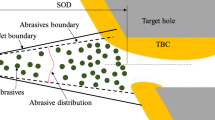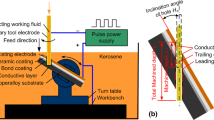Abstract
The micro- and small-sized cooling holes of turbine blades must be polished to remove the thermal barrier coating (TBC) blockage before service. To date, no effective methods have been developed to remove this blockage, except for manual polishing using grinding needles. In this study, the removal of hole blockages from a superalloy material is investigated using a low-pressure abrasive water jet (AWJ) process for the first time. Based on an analysis of the processing mechanism, the kinetic energy threshold for a particle-to-crack TBC is approximate 3.55 nJ. Garnet particles with size of 10 μm and speed of ≥ 60 m/s can theoretically damage the TBC material. For vertical holes, the hole-blocked material near the entrance can be eroded rapidly. For inclined holes, the hole-blocked material at the trailing edge has a much greater volume and length and requires a longer time to remove. Using relatively larger jet size increases the material removal rate of the blockage, however, resulting in a broader hole entrance. When applying a relatively larger standoff distance, the capability of the AWJ in removing the blockage was enhanced owing to the more dispersed distribution of abrasives in the jet. The blockage ratio can be reduced from 60% to approximately 25% after 90 s of AWJ processing. Furthermore, the impingement of abrasives can remove the recast layer from the hole wall caused by electrical discharge drilling prior to coating.




















Similar content being viewed by others
Data availability
The datasets used or analyzed during the study are available from the corresponding author on reasonable request.
References
Gao R, Mao W, Wang Y, Fan S, Shao W (2021) Intelligent life prediction of thermal barrier coating for aero engine blades. Coatings 11:890. https://doi.org/10.3390/coatings11080890
Zhang Y, Liu P, Li Z (2022) Impact of cooling with thermal barrier coatings on flow passage in a gas turbine. Energies 15(1):85. https://doi.org/10.3390/en15010001
Wee S, Do J, Kim K, Lee C, Seok C, Choi B-G, Choi Y, Kim W (2020) Review on mechanical thermal properties of superalloys and thermal barrier coating used in gas turbines. Appl Sci 10(16):5476. https://doi.org/10.3390/app10010016
Wu S, Zhao Y, Li W, Liu W, Wu Y, Liu F (2021) Research progresses on ceramic materials of thermal barrier coatings on gas turbine. Coatings 11(1):79. https://doi.org/10.3390/coatings11010001
Keyvani A, Bahamirian M, Kobayashi A (2017) Effect of sintering rate on the porous microstructural, mechanical and thermomechanical properties of YSZ and CSZ TBC coatings undergoing thermal cycling. J Alloys Compd 727:1057–1066. https://doi.org/10.1016/j.jallcom.2017.08.184
Uczak de Goes W, Ossiansson M, Markocsan N, Gupta M, Honnerova P, Vesely Z (2022) Influence of spray angle on microstructure and lifetime of suspension plasma-sprayed thermal barrier coatings. J Therm Spray Tech 31:2068–2090. https://doi.org/10.1007/s11666-022-01436-7
Bobzin K, Brgelmann T, Kalscheuer C, Yildirim B, Welters M (2020) Correlation of thermal characteristics and microstructure of multilayer electron beam physical vapor deposition thermal barrier coatings. Thin Solid Films 707. https://doi.org/10.1016/j.tsf.2020.138081
Chen X, Kuroda S, Ohnuki T, Araki H, Watanabe M, Sakka Y (2016) Effects of processing parameters on the deposition of yttria partially stabilized zirconia coating during suspension plasma spray. J Am Ceram Soc 99:3546–3555. https://doi.org/10.1111/jace.14393
Ebrahimzade V, Uchtmann H, Singheiser L, Krüger M, Malzbender J (2019) Microstructure and cyclic oxidation behavior of APS TBC systems drilled with various laser methods. Surf Coat Technol 378:125018. https://doi.org/10.1016/j.surfcoat.2019.125018
Li H, Zhang D, Han F, Guo H, Ding X (2021) Experimental investigation on the effect of hole diameter on the leading edge region film cooling of a twist turbine blade under rotation conditions. Appl Therm Eng 184:116386. https://doi.org/10.1016/j.applthermaleng.2020.116386
Ke T, Ahmed G, Jin W, Chen Z, Sundén B (2017) Effect of hole blockage configurations on film cooling in gas turbine components. Chem Eng Trans 61:229–234. https://doi.org/10.3303/CET1761036
Zhang W, Zeng R, Liu S, Li G (2022) Effect of blockage inside holes on film cooling performance on the suction side of a turbine guide vane. Energies 15(8):2935. https://doi.org/10.3390/en15010008
Chen X, Wang Y, Long Y, Weng S (2021) Effect of partial blockage on flow and heat transfer of film cooling with cylindrical and fan-shaped holes. Int J Therm Sci 164:106866. https://doi.org/10.1016/j.ijthermalsci.2021.106866
Zhou J, Zhang J (2016) Effects of partial blockage inside film holes on overall cooling effectiveness of an integrated impingement-fin-film cooling configuration on blade pressure side. Acta Aeronaut Astronaut Sin 37:2729–2738. https://doi.org/10.7527/S1000-6893.2016.0067
Vasudevan B, Natarajan Y, Sivalingam V, Krolczyk G, Tandon P (2022) Insights into drilling film cooling holes on ceramic-coated nickel-based superalloys. Archiv Civ Mech Eng 22:141. https://doi.org/10.1007/s43452-022-00465-x
Lu C, Duan W, Wang K, Wang R, Tang Z (2020) Experiments of drilling micro-holes on superalloy with thermal barrier coatings by using femtosecond laser. Ferroelectrics 564(1):37–51. https://doi.org/10.1080/00150193.2020.1761697
Wang L, Chi G, Chen L, Guo Y (2018) Interfacial characteristics investigation for one-step EDM drilling of cooling holes in TBCs. J Mater Eng Perform 27(12). https://doi.org/10.1007/s11665-018-3728-5
Dong Y, Li X, Zhao Q, Li X, Dou Y (2017) Geometrical modeling to improve the accuracy of drilled cooling holes on turbine blades. Int J Adv Manuf Technol 93:4409–4428. https://doi.org/10.1007/s00170-017-0818-8
Cao Z, Wang M, Yan S, Chao Z, Liu H (2023) Surface integrity and material removal mechanism in fluid jet polishing of optical glass. J Mater Process Technol 311. https://doi.org/10.1016/J.JMATPROTEC.2022.117798
Akincioglu S (2021) Investigation of effect of abrasive water jet (AWJ) machining parameters on aramid fiber-reinforced polymer (AFRP) composite materials. Aircr Eng Aerosp Technol 93(4):615–628. https://doi.org/10.1108/AEAT-11-2020-0249
Altin Karataş M, Gokkaya H, Akincioglu S, Biberci M (2022) Investigation of the effect of AWJ drilling parameters for delamination factor and surface roughness on GFRP composite material. Multidiscip Model Mater Struct 18(4):734–753. https://doi.org/10.1108/MMMS-04-2022-0071
Liu Z, Gao C, Wang Z, Yu X (2022) Investigation of cooling hole blockage in the plasma spraying of thermal barrier coatings on super-alloy. Trans Inst Met Finish. https://doi.org/10.1080/00202967.2022.2094586
Nouraei H, Wodoslawsky A, Papini M, Spelt JK (2013) Characteristics of abrasive slurry jet micro-machining: a comparison with abrasive air jet micro-machining. J Mater Process Technol 213:1711–1724. https://doi.org/10.1016/j.jmatprotec.2013.03.024
Wiederhorn SM, Lawn BR (1979) Strength degradation of glass impacted with sharp particles: I, Annealed surfaces. J Am Ceram Soc 62:66–70. https://doi.org/10.1111/j.1151-2916.1979.tb18808.x
Lawn BR, Evans AG, Marshall DB (1980) Elastic/plastic indentation damage in ceramics: the median/radial crack system. J Am Ceram Soc 63:574–581. https://doi.org/10.1111/j.1151-2916.1980.tb10768.x
Slikkerveer PJ, Bouten PCP, Veld FH, Scholten H (1998) Erosion and damage by sharp particles. Wear 217:237–250. https://doi.org/10.1016/S0043-1648(98)00187-2
Jafar RHM, Nouraei H, Emamifar M, Papini M, Spelt JK (2015) Erosion modeling in abrasive slurry jet micro-machining of brittle materials. J Manuf Process 17:127–140. https://doi.org/10.1016/j.jmapro.2014.08.006
Funding
This work was supported by the Primary Research and Development Plan of Jiangsu Province (China, grant number BE2022150) and National Science and Technology Major Project (China, grant number 2017-VII-0015-0111).
Author information
Authors and Affiliations
Contributions
Zhuang Liu: conceptualization, methodology, and writing (reviewing and editing). Changshui Gao: experiment design and supervision. Lijun Xiao: original draft preparation and results inspection. Zhongyu Wang: experiment performance and result inspection.
Corresponding authors
Ethics declarations
Ethics approval
There are no ethical issues to declare.
Consent to participate
All the authors participate in the research work of this paper.
Consent for publication
All authors agree to publish the results in this paper.
Competing interests
The authors declare no competing interests.
Additional information
Publisher’s note
Springer Nature remains neutral with regard to jurisdictional claims in published maps and institutional affiliations.
Rights and permissions
Springer Nature or its licensor (e.g. a society or other partner) holds exclusive rights to this article under a publishing agreement with the author(s) or other rightsholder(s); author self-archiving of the accepted manuscript version of this article is solely governed by the terms of such publishing agreement and applicable law.
About this article
Cite this article
Liu, Z., Gao, C., Xiao, L. et al. Removing hole blockages from thermal barrier coatings using low-pressure abrasive water jet. Int J Adv Manuf Technol 127, 1419–1431 (2023). https://doi.org/10.1007/s00170-023-11642-4
Received:
Accepted:
Published:
Issue Date:
DOI: https://doi.org/10.1007/s00170-023-11642-4




